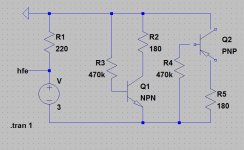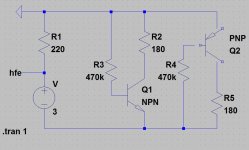Hello,
In search for an ultra-simple hfe-meter I found this on the EEVblog:
How come transistor beta hFE test is only on cheap DMMs? - Page 1
After simulating in spice and adjusting the resistor values a bit, I decided to give it a go - dead pcb style. Materials are a 3V battery w/holder, 5 resistors, one 8-pin ic-socket and some random piece of leftover board. It seems to work but accuracy is no good, but it makes it possible to select and match transistors.
Please enjoy
nnx
In search for an ultra-simple hfe-meter I found this on the EEVblog:
How come transistor beta hFE test is only on cheap DMMs? - Page 1
After simulating in spice and adjusting the resistor values a bit, I decided to give it a go - dead pcb style. Materials are a 3V battery w/holder, 5 resistors, one 8-pin ic-socket and some random piece of leftover board. It seems to work but accuracy is no good, but it makes it possible to select and match transistors.
Please enjoy
nnx
Attachments
Q2 is drawn wrong, upside down!
Answer to your question is because if you purchase a quality DVM, one requires all the cost to be for a DVM. One can purchase a transistor tester separately and very cheaply.
Answer to your question is because if you purchase a quality DVM, one requires all the cost to be for a DVM. One can purchase a transistor tester separately and very cheaply.
Corrected!
Thank you for the comment! Q2 was upside down, but has now been rotated in the schematics. The output from the tester is in millivolts, one mV approximates one "degree" of hfe.
Of course it would be better with a proper dvm with built-in tester, or a dedicated transistor tester. But this is just a little fun project.....
Thank you for the comment! Q2 was upside down, but has now been rotated in the schematics. The output from the tester is in millivolts, one mV approximates one "degree" of hfe.
Of course it would be better with a proper dvm with built-in tester, or a dedicated transistor tester. But this is just a little fun project.....
Attachments
Q2 is drawn wrong, upside down!
Answer to your question is because if you purchase a quality DVM, one requires all the cost to be for a DVM. One can purchase a transistor tester separately and very cheaply.
There is also the safety aspect. A transistor tester on a DMM pretty much always exposes the voltages on the inputs on the transistor tester pins as well. This is both a risk for arc over a well as shock/electrocution of someone who might have their hands near the pins. Combine this with the fact that the transistor tester in these devices gives you a very relative value and it just becomes too many negatives to include in a quality meter.
- Status
- Not open for further replies.
![IMG_20160130_172412_HDR[1].jpg](/community/data/attachments/471/471866-4ace4ee34dc1a016264d436cfe66f871.jpg?hash=Ss5O403BoB)
![IMG_20160130_172506_HDR[1].jpg](/community/data/attachments/471/471883-13ee29d6af1975974a63686cb8843093.jpg?hash=E-4p1q8ZdZ)

